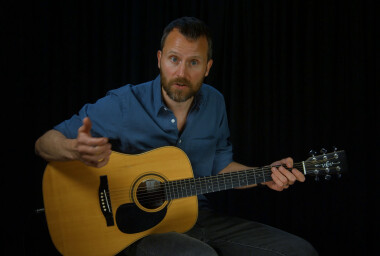Guitar Fundamentals Course 1
Jump right in and get to the fun stuff! In Fundamentals Course 1 you’ll learn how to play guitar chords, some killer riffs, a few cornerstone guitar scales, guitar strumming and rhythm, how to use a guitar tuner and much more so you can get started making music. Don’t forget the toolbox with a guitar chord chart, a guitar scale finder, an online guitar tuner and more tools that make learning to play guitar easy. Welcome to Guitar Tricks!
Chapter: 1: Getting Familiar With Your Instrument
In this chapter you will learn the names of the strings and how to tune your guitar. After that you will be ready to learn the basic mechanics of fretting and picking and strumming notes. Also in included in this first chapter are beginner chords.
Recommended Songs
Now that you know some open chords, jump right in to some easy guitar songs like Speed of the Sound of Loneliness (Made Easy), Wooly Bully (Made Easy), and Perfect (Made Easy).In this first tutorial of Guitar Fundamentals we'll learn proper posture and how to hold the guitar. We will also learn how to use the tuning pegs and tune up, then learn the string names: Eddie Ate Dynamite, Goodbye Eddie! Once we're tuned up and in position we'll look at how to navigate the fretboard using string names and fret numbers, while also exploring about how to best fret notes. You can start out using just your index finger, but after that you should try using your other 3 fingers as well.
Published: 11/29/2021 UpgradeNow that you know how to navigate the fretboard and play notes, it's time to try playing some simple chords: E minor and G major. If you or anyone in your life sings, you'll be able to play your very first song the end of this tutorial.
Published: 11/29/2021 UpgradeUp until now we've focused almost exclusively on our left hand, so now it's time to turn our attention towards our right hand for a bit. We'll explore the different ways you can strum and pick with your fingers and of course we'll talk about how to use an actual pick. We'll talk about the different types of picks and how to choose the right one for you, how to hold it and of course we'll try it all out in some musical examples.
Published: 11/29/2021 UpgradeNow it's time to explore your first two chords that use all six strings: the full E minor chord and the full A minor chord. This will be a little harder for your left hand, but in return it makes it easier for your right hand. And most importantly it sounds great!
Published: 11/29/2021 UpgradeIn this tutorial we'll learn two new and extremely important chords: C major and D major. These chords are a bit harder than the ones you've learned up until now, but as always we'll take it nice and slow and if you remember to stay patient and positive, your fingers will figure it out eventually. And as an extra bit of motivation I can tell you that once you add these two chords in with the ones you learned earlier you'll have a collection of chords that can be used to play thousands of songs.
Published: 11/29/2021 UpgradeIn this tutorial we'll tackle the challenge of chord transitions by combining all the chords we've learned so far in various useful combinations. This may seem like a lot of work, but we're dealing with chords that are used all the time here, so it really is worth the extra focus.
Published: 11/29/2021 UpgradeChapter: 2: Learning Rhythm
In this chapter you will learn the basics of rhythm: counting in time, rhythmic subdivisions. After that you will learn to apply those rhythms to basic strumming patterns using basic chords. You will also learn how to use a metronome.
Rhythm is one of the most powerful concepts you can master and learning it early on will only put you ahead of the curve. In this tutorial we'll learn the basics of rhythmic counting and subdivisions.
Published: 11/29/2021 UpgradeIn this tutorial we'll explore the most basic version of what's called a strumming pattern using the chords we've learned so far. The idea is that you could now use this rhythmic pattern to go play a million different songs. As your skills grow we'll keep building on this strumming pattern to make it more and more cool sounding and useful.
Published: 11/29/2021 UpgradeIn this tutorial we'll explore a new type of subdivision and a whole new way to play it with your right hand: an upstroke. This technique may be a challenge for you at first, particularly when it comes to holding your pick. But it's an absolutely crucial skill for a guitar player on any level, and as always we'll take it one step at a time.
Published: 11/29/2021 UpgradeIn this tutorial I'll introduce you to a brand new tool that will be helpful from now on and throughout the rest of your guitar playing journey. In itself it's not particularly exciting, but it can help you do some really exciting things. The tool is called a metronome, and it's used by everyone from beginners to virtuosos.
Published: 11/29/2021 UpgradeChapter: 3: Playing Melodies
In this chapter you will learn the major scale, the pentatonic scale, musical alphabet note letter names and locations. After that you'll learn to play a variety of beginner level single note melodies. Also including are finger exercises to increase your strength and dexterity.
Recommended Songs
Practice your new single-note skills with these melodies: The Star Spangled Banner, Simple Melodies for Classical Guitar, More Simple Melodies For Classical Guitar.In this chapter we'll be exploring the exciting topic of melodies. This is where our guitar steps out of the supporting role and becomes the center of attention. If you took the time, you could most likely use your ears and eventually be able to find where the notes are to play a certain melody - but you would quickly realize that it's a lot of work to search around blindly on the neck like that. So in this lesson we'll get around that by learning what's called a major scale, and then you'll be able to find so many melodies within that scale.
Published: 11/29/2021 UpgradeIn the previous tutorial we explored how our major scale pattern ended with the same note we started on. In this tutorial we'll extend the scale to play it beyond one octave. Among many other melodies, this will give us access to the classic melody 'Happy Birthday To You'.
Published: 11/29/2021 UpgradeIn this tutorial I'll teach you what I'm fairly certain is the most popular scale on guitar. This scale is called the minor pentatonic scale and it's used almost every time you hear someone play a guitar solo, from absolute beginners to world famous guitar players.
Published: 11/29/2021 UpgradeIn this tutorial we'll take the first important step on the journey towards understanding the fretboard on a deeper level than just fret numbers and visual shapes. We'll learn the musical alphabet notes and how to locate them on the guitar.
Published: 11/29/2021 UpgradeA big part of learning to play guitar consists of trying to get your fingers to do a number of things they have never tried before. In this tutorial I'm going to show you some exercises that you can use to get your hands and fingers more comfortable with these new challenges. These exercises aren't meant to sound great, but they can still be really fun to work on.
Published: 11/29/2021 UpgradeChapter: 4: Riffs and Power Chords
In this chapter you will learn how to play single note riffs and power chords. There examples will focus on rock and blues styles.
Recommended Songs
Try your new guitar riff skills on these iconic tunes: Smoke On The Water (Made Easy), My Sharona (Made Easy).In this tutorial we'll explore the most basic example of what's called a power chord. Power chords are a super useful tool and they're tons of fun to play around with. We'll also use the musical alphabet notes to name the power chords.
Published: 11/29/2021 UpgradeOne of the best things about playing guitar is that we get play what's called riffs. The word riff is used in many different ways, but in this context most people use it to describe an instrumental part in a song that's instantly recognizable and often happens several times throughout the song. It's that guitar part that makes everyone know what the song is right away!
Published: 11/29/2021 UpgradeNow it's time to try out another fun example of a riff and construct a cool song around it. We'll use the same song form, where we start with the riff, then continue with the verse leading to our first chorus. Then we'll repeat the riff and do the second verse and second chorus. And then finally we'll end the song with the riff. So it'll be the same structure, but our parts and the overall song will be entirely different.
Published: 11/29/2021 UpgradeIn this tutorial we'll explore a classic blues riff, which can be used like the riffs we've explored up until now as a signature part of the song, but it can also be used as a supportive rhythm guitar part for the rest of the song.
Published: 11/29/2021 UpgradeHopefully you're having fun with these riffs and songs, because we're going to do one more. I'm sure you'll recognize the sound of this riff, because it's been used in so many songs over the years. We'll combine that with our blues riff from the previous tutorial and then we'll use it all to play a whole little blues song.
Published: 11/29/2021 UpgradeChapter: 5: More Chords
In this chapter you will learn all the basic open chords used in many songs. After that you'll learn to play these chords in groups of important basic key signatures. You will get a lot of practice playing these chords along with beginner song examples.
Recommended Songs
Each new guitar chord you add opens access to hundreds more songs. Try these - Bad Moon Rising (Made Easy), Two Tickets To Paradise (Made Easy), Let It Be (Made Easy), Who Will Save Your Soul (Made Easy), Stay (Made Easy).In this tutorial we'll add the full G major chords to your arsenal. This one requires an extra bit of left hand finger stretching, but it is probably one of the most frequently used chords on the guitar, so it's more than worth the extra effort. Once we've gone through and practiced the full G chord, we'll combine it with our C and D chords and you'll see how these three chords share a very special relationship.
Published: 11/29/2021 UpgradeIn this tutorial we'll add the classic A major chord to the arsenal. This one can be a little tricky as well, but it's so common that it's entirely worth the extra effort. Once we've practiced the full chord shape we'll combine it two other chords to get a whole little chord family in the key of A.
Published: 11/29/2021 UpgradeIn this tutorial we'll add another very important chord to your arsenal, the F major chords. The traditional way to play the F chord is one of the hardest of the open chords, but in this tutorial we’ll learn an easier way to get around that. Someday you'll probably want to learn the harder version too, but the F chord is so common that it's really useful to have an easier alternative in the meantime.
Published: 11/29/2021 UpgradeIn this tutorial we'll add the D minor chord to the arsenal, and then explore what it sounds like when we combine it with the A minor and E minor chords. Once again, the most important thing to get from this tutorial is to learn the D minor chord and practice switching between that and two of the most common chord shapes that are used along with it: A minor and E minor.
Published: 11/29/2021 UpgradeChapter: 6: Trouble Shooting
In this chapter you will learn to troubleshoot some of the most common problems beginner guitar students face. Included in this list is how to deal with finger pain, building calluses, proper posture and advice on how to overcome impatience and frustration. Also included is information on different types of tuners and different methods of tuning your guitar.
In this chapter we'll go through some of the most common issues and questions people have when they're first starting out with the guitar. In this first tutorial we'll talk about all the physical aspects of guitar playing: posture, calluses, hand, finger, arm pain as well as what to do about your fingernails.
Published: 11/29/2021 UpgradeWhen people first start wrestling with some of the more challenging things on guitar, it's completely normal to wonder if it's supposed to be this hard. Sometimes the answer is unfortunately yes, but other times it does have to do with the physical specifications of the guitar you're playing. So in this tutorial we'll talk about how to find out if your particular guitar really is making it more difficult than it needs to be.
Published: 11/29/2021 UpgradeLearning guitar is a lot of fun, but as you know it isn't easy. On good days the challenges feel exciting and we patiently practice our way towards a certain goal. But it is completely inevitable that you also hit a lot of low points along the way days where nothing is easy and you wonder how you're ever going to get good at this. Maybe you're in one those spots right now, and if that's the case just put your guitar, give your fingers a break and let's talk about how to get over the hump and back on the horse.
Published: 11/29/2021 UpgradeIn this tutorial we're gonna talk in more detail about tuning. Tuning can be a tricky thing, and it's something we have to do all the time on the guitar. Guitars are made of wood and is constantly reacting to the climate around you, which will affect your tuning. Also, when we strum, fret and pick the strings we push and pull them and even the slightest change in the string tension will affect the pitch and your overall tuning. So tuning is part of playing guitar, and it's something we have to do every time we pick up a guitar and most likely several times throughout our practice session or performance.
Published: 11/29/2021 Upgrade


























